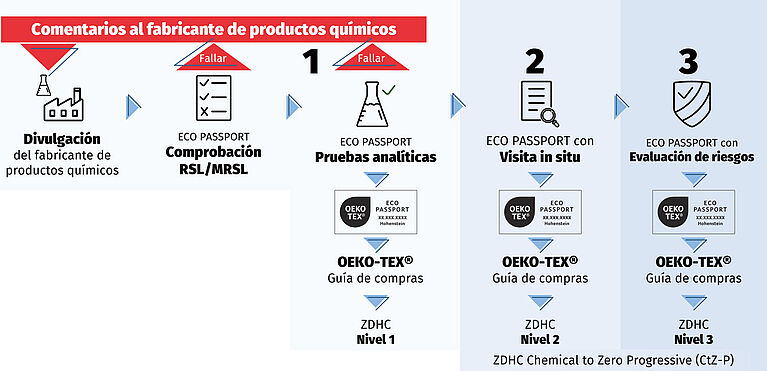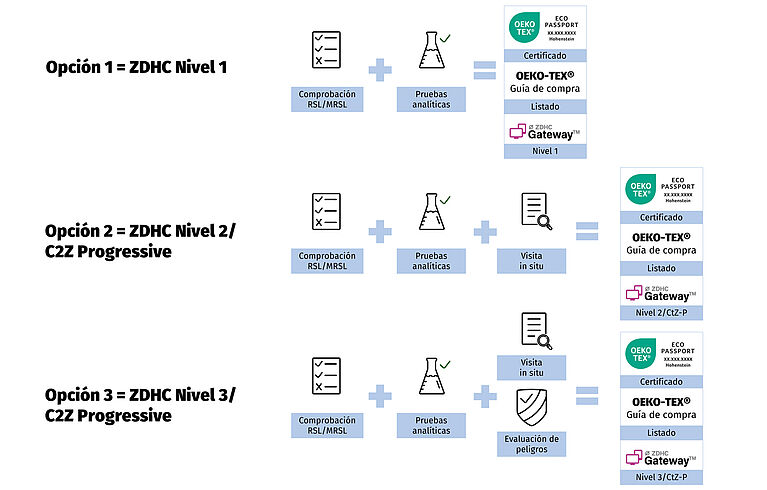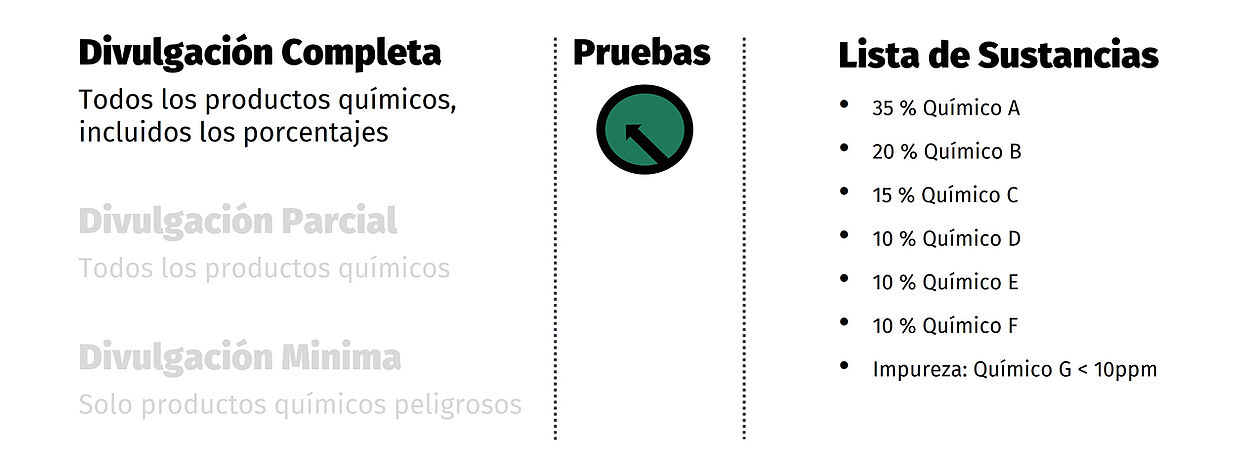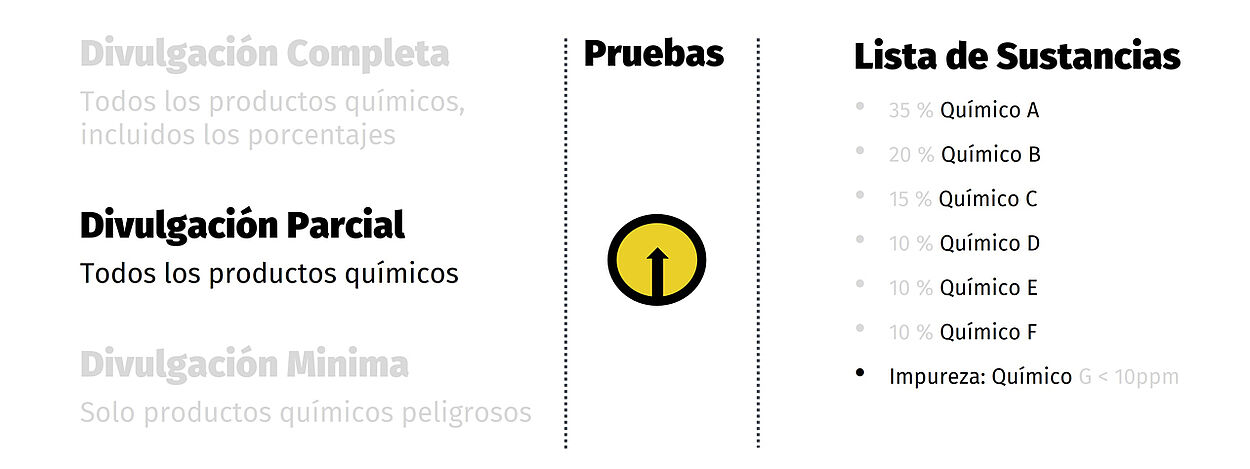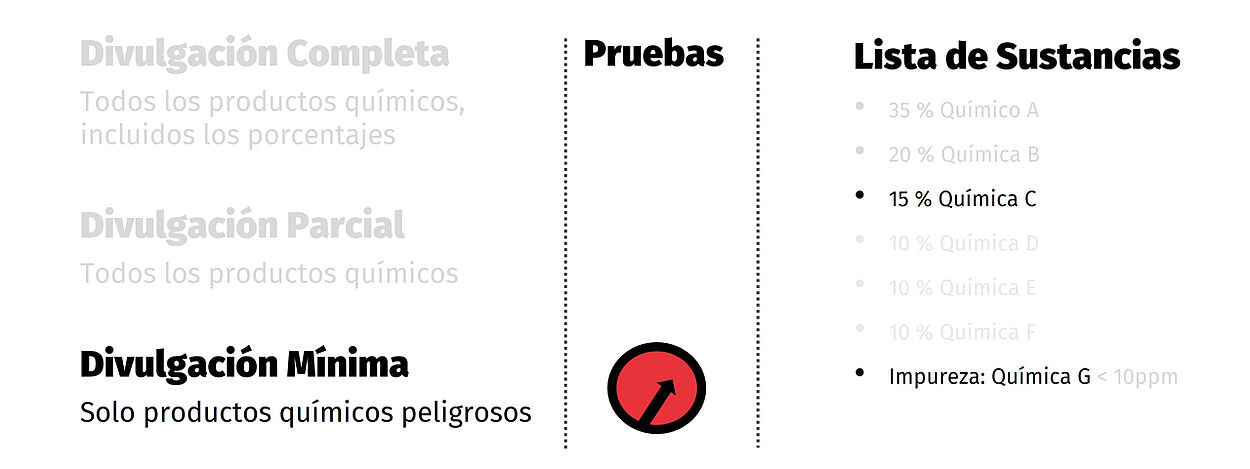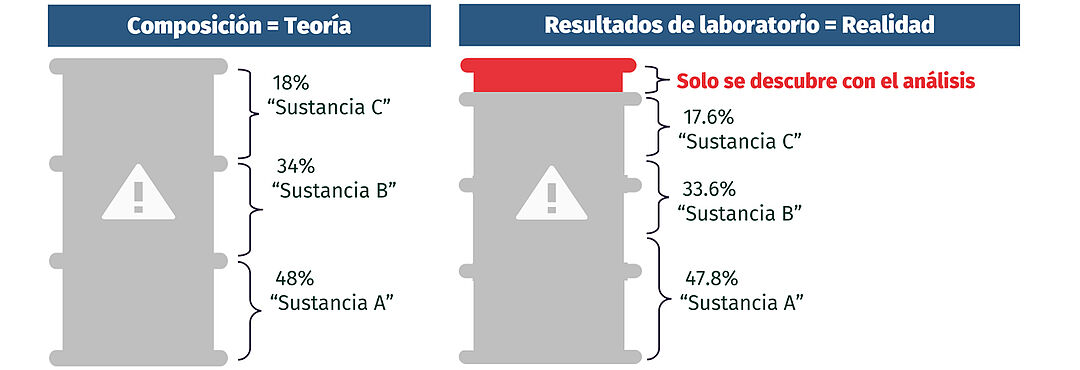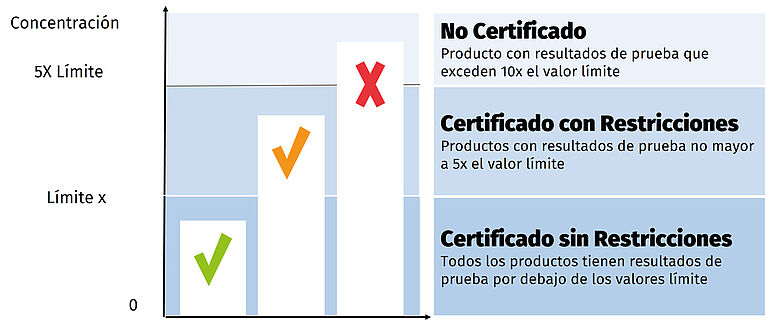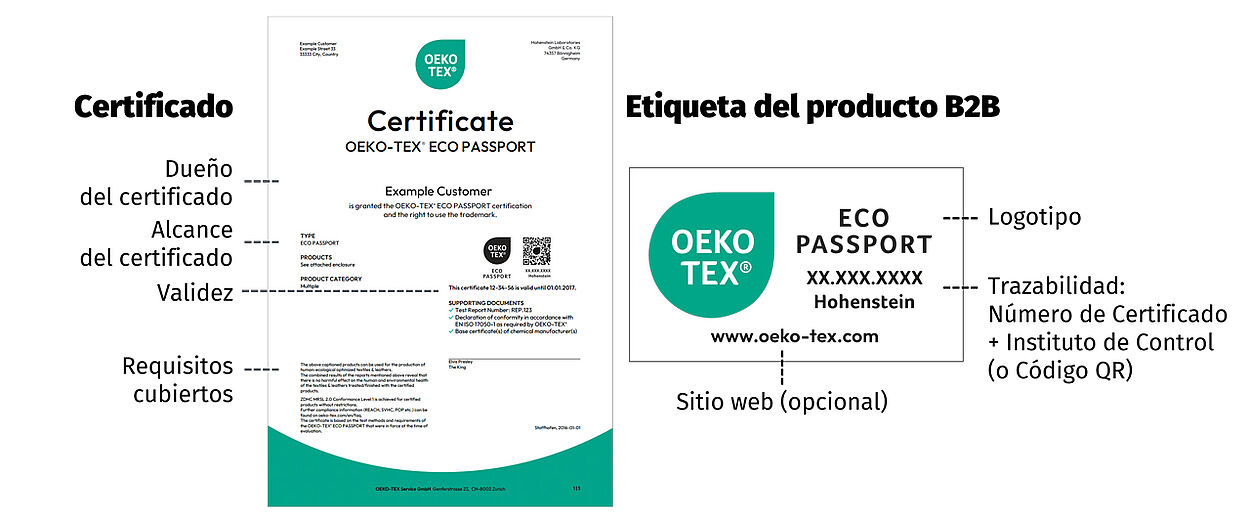¿Qué hace OEKO-TEX® ECO PASSPORT?
ECO PASSPORT examina, prueba y certifica las sustancias químicas antes de que entren en las cadenas de suministro textil y del cuero. Protege a los trabajadores, al medio ambiente y a los consumidores finales de sustancias nocivas.
¿Qué sustancias tóxicas restringe ECO PASSPORT?
OEKO-TEX® ECO PASSPORT prohíbe o restringe más de 1.000 sustancias nocivas para la salud humana y el medio ambiente. La lista de sustancias restringidas (RSL/MRSL) se basa en datos científicos, normativas mundiales y métodos de producción.
Los ejemplos incluyen:
- Formaldehído
Se utiliza comúnmente para mejorar la durabilidad de las telas y la resistencia a las arrugas; la exposición puede causar problemas respiratorios e irritación de la piel (CDC) (CDC) - Sustancias perfluoroalquiladas y polifluoroalquiladas (PFAS)
Aplicado para repeler agua, grasa y suciedad; persistente en el medio ambiente y puede alterar la función endocrina (EPA) - Ftalatos
A menudo utilizados como plastificantes en materiales sintéticos; asociados con problemas de salud reproductiva y del desarrollo (NIH) - Colorantes azoicos
Colorantes sintéticos que pueden liberar aminas cancerígenas durante su degradación; riesgos para la salud causados por exposición prolongada (NIH) - Retardantes de llama (por ejemplo, compuestos bromados)
Añadidos para reducir la inflamabilidad; algunos son tóxicos, bioacumulativos y están relacionados con problemas neuroconductuales (NIEHS). (NIEHS) - Metales pesados (por ejemplo, plomo, cadmio, cromo)
Utilizados en tintes y pigmentos; la exposición puede causar daños a los órganos (ATSDR) - Compuestos orgánicos volátiles (COV) (por ejemplo, benceno, tolueno)
Disolventes utilizados en el procesamiento de textiles; puede provocar efectos respiratorios y neurológicos (EPA) - Etoxilatos de nonilfenol (NPEs)
Utilizados en detergentes y surfactantes, que se degradan en nonilfenol; tóxicos para la vida acuática (EPA) - Compuestos organoestánnicos
Biocidas: Pueden afectar los sistemas inmunológico y reproductivo (PubChem) - Anilina
Se utiliza para producir tintes; es tóxico para los órganos y la vida acuática (NIH) - Bencenos y toluenos clorados
Se utiliza para producir colorantes y solventes, absorber colorantes, desengrasar materias primas; toxicidad cancerígena y reproductiva y riesgos para los organismos acuáticos (NIH) - Siloxanos
Se utiliza para mejorar la suavidad, la repelencia al agua, la durabilidad y la apariencia, repeler la suciedad de aceite o grasa; riesgo de bioacumulación (NIH)
¿Qué tipos de productos químicos se pueden certificar?
Todos los productos químicos, colorantes, auxiliares y formulaciones utilizados para la producción de textiles y cuero pueden certificarse con ECO PASSPORT.
- Auxiliares
- Producción de fibras, hilos, tejidoses, espumas y cauchos
- Teñido e impresión
- Ácidos, bases, sales, disolventes
- Antiespumantes/deslizantes, niveladores
- Antiespumante/estabilizador
- Penetrador
- Modificador reológico
- Tratamientos de aguas/efluentes
- Auxiliares técnicos (humectantes, antiespumantes, detergentes, dispersantes, emulsionantes, desmanchantes, quelantes, estabilizantes)
- Auxiliares de procesado (enherbado, desengrasado, curtido, recurtido)
- Colorantes
- Colorantes (ácidos, básicos, dispersos, directos, reactivos, azoicos, de cuba, sulfurosos, disolventes, naturales, metálicos)
- Pigmentos (inorgánicos, orgánicos, metálicos, complejos)
- Pastas de estampación, tintas (con/sin colorantes)
- Acabado con disolventes
- Auxiliares/agentes de acabado
- Agentes de recubrimiento/aditivos (base disolvente/acuosa/plastisol)
- Engrasantes y aceites
- Adhesivos
- Ignífugos y antimicrobianos autorizados
- Agentes de limpieza (en seco, acuosos, inorgánicos, desengrasado)
- Polymers, masterbatches
- Resinas sintéticas/pellets
- Productos químicos básicos (Rectificadores de pH, rectificadores de oxidación, agentes quelantes, tratamiento de aguas residuales y efluentes, otros)
Restricciones
Los explosivos, cosméticos, medicamentos y productos químicos microencapsulados NO pueden certificarse.
Las fragancias para neutralizar olores fuertes y desagradables en un producto químico sí pueden certificarse. Pero las fragancias para agregar un aroma agradable NO pueden certificarse.
¿Quién puede solicitar un certificado ECO PASSPORT?
- Cualquier fabricante de productos químicos para el sector textil o del cuero puede solicitar la certificación ECO PASSPORT. ECO PASSPORT es adecuado para todos los productos químicos (sustancias químicas, colorantes y auxiliares) - y sus formulaciones- que se utilizan en los sectores textil, del cuero, de la confección, del calzado, de los textiles para el hogar o similares
- Los mayoristas y revendedores de productos químicos también pueden solicitar un certificado en su propio nombre para los productos que ya estén cubiertos por el certificado del fabricante de productos químicos y no se hayan realizado cambios adicionales en la composición
Si no se dispone de un certificado del fabricante, los distribuidores y minoristas pueden solicitar una certificación limitada. Esta certificación temporal sólo puede renovarse una vez para una validez máxima del certificado de dos años en total. (La renovación anual del certificado para los fabricantes de sustancias químicas no está limitada)
¿Cómo certifica OEKO-TEX® ECO PASSPORT los productos químicos?
- Comprobación RSL/MRSL
Proceso transparente para detectar sustancias químicas preocupantes mediante la comparación eficaz de los números CAS - Los ingredientes químicos se comparan con la lista OEKO-TEX® de sustancias químicas nocivas (~1500 sustancias químicas que nos esforzamos por mantener fuera de la cadena de suministro). - Pruebas analíticas
Verificación analítica en nuestros laboratorios para garantizar que las sustancias químicas pueden utilizarse para la producción sostenible de productos textiles o de piel seguros para la ecología humana. (Las formulaciones se certifican al nivel mínimo con la opción de continuar a niveles superiores) - Visita in situ (Opcional)
Control en las instalaciones del proveedor de productos químicos para comprobar el sistema de gestión del producto (para el nivel 2 de ZDHC/nivel ZDHC Chemical to Zero Progressive (CtZ-P))
- Además de añadir preguntas opcionales de evaluación de peligros (para ZDHC nivel 3/nivel ZDHC Chemical to Zero Progressive (CtZ-P))
¿Qué regulaciones cubre OEKO-TEX® ECO PASSPORT?
OEKO-TEX® ECO PASSPORT está diseñado para apoyar el cumplimiento químico global y el abastecimiento responsable. Cumple con los requisitos de las principales regulaciones y normas de la industria, incluyendo:
Reglamento REACH (Reglamento (CE) No. 1907/2006)
- Los valores límite se alinean con las entradas relevantes de los Anexos XVII y XIV
- Las Sustancias Altamente Preocupantes (SVHCs) de la Lista de Candidatos de la ECHA se incluyen si son relevantes para textiles o cuero
- Apoya el Artículo 33 de REACH al reducir las obligaciones de comunicación en la cadena de suministro
Reglamento de Contaminantes Orgánicos Persistentes (POPs) de la UE (Reglamento (UE) 2019/1021)
- Cumple con las restricciones sobre contaminantes orgánicos persistentes
Conformidad con la MRSL de ZDHC
- Reconocida por la Fundación ZDHC
- Facilita la conformidad con la MRSL de ZDHC más reciente, incluyendo los niveles 1, 2 y 3
Alineación con la RSL del Grupo AFIRM
- Monitoreada regularmente con la Lista de Sustancias Restringidas del Grupo AFIRM
- Revisada frente a listas MRSL/RSL adicionales de origen legal o de grupos de interés
¿Cuáles son las opciones para la integración ZDHC?
Todas las opciones incluyen la inclusión en la Guía de compra OEKO-TEX® y el uso de la etiqueta de producto OEKO-TEX® ECO PASSPORT.
La opción 1 permite la inclusión en la lista del portal ZDHC de nivel 1.
La opción 2 añade una visita in situ para la gestión del producto y permite la inclusión en el nivel 2 de la lista ZDHC Gateway y el nivel ZDHC Chemical to Zero Progressive (CtZ-P).
La opción 3 añade preguntas de evaluación de riesgos químicos a la visita in situ y permite la inclusión en el nivel 3 de ZDHC Gateway y el nivel ZDHC Chemical to Zero Progressive (CtZ-P).
¿Cómo puedo hacer que mi producto aparezca en ZDHC?
- Contacta directamente con ZDHC y obtén acceso al Chemical Gateway
- Envíe el registro de su producto
- Proporcione su certificado y número OEKO-TEX® ECO PASSPORT como prueba de cumplimiento con los estándares ZDHC
- A través de una integración con nuestra base de datos, ZDHC verificará automáticamente la validez y clase de la certificación ECO PASSPORT
¿Cuánta divulgación se requiere?
Proteger la confidencialidad al tiempo que se reducen las tasas:
Reconocemos que las formulaciones químicas y las listas de sustancias (BoS) son propiedad intelectual altamente protegida. La información proporcionada es encriptada y almacenada por el instituto certificador y OEKO-TEX®. Ninguna receta se comparte públicamente en ningún sitio.
- No es obligatorio revelar el 100% de su formulación
- Cuanto más pueda revelar sobre su formulación, más fácil será el proceso de certificación
- Una mayor divulgación reduce sus costos de ensayo
- La confidencialidad está integrada en el sistema, pero estaremos encantados de firmar un acuerdo adicional de no divulgación (NDA)
- Para proteger a los miembros de los equipos de laboratorio durante su manipulación, OEKO-TEX® exige la divulgación de todas las sustancias constituyentes y contaminantes/productos derivados conocidos que estén regulados por OEKO-TEX® o clasificados como peligrosos por GHS o el artículo 57 del reglamento REACH 1907/2006
Opciones de nivel de divulgación: divulgue más, pruebe menos:
Co niveles de divulgación más elevados, se reducen el esfuerzo de ensayo, el tiempo y los costos de la fase de verificación analítica.
¿Por qué se requiere la verificación analítica?
Lo divulgado no siempre coincide con la realidad. Los ensayos garantizan que las sustancias químicas certificadas no contienen impurezas ni productos secundarios no deseados (disolventes incorrectos, metales, tensioactivos, etc.).
¿Por qué OEKO-TEX® realiza pruebas de biodegradabilidad de los productos químicos?
Algunos productos químicos (por ejemplo, surfactantes, suavizantes y agentes complejantes) utilizados en la producción de textiles y cuero terminan en las aguas residuales. La certificación OEKO-TEX® ECO PASSPORT exige que estos productos químicos no dañen permanentemente los ecosistemas.
Requisitos de biodegradabilidad:
- Suavizantes y agentes complejantes: 90 % en peso de los componentes biodegradables en condiciones aeróbicas o inherentemente biodegradables y/o eliminables en plantas de tratamiento de aguas residuales
- Surfactantes: biodegradables en condiciones aeróbicas
- Surfactantes no iónicos y catiónicos: también biodegradables en condiciones anaeróbicas
Estos métodos de prueba pueden ser realizados por cualquier laboratorio terciario"
- OECD 301 A
- ISO 7827 OECD 301 B
- ISO 9439 OECD 301 C
- OECD 301 D
- OECD 301 E
- OECD 301 F
- ISO 9408 OECD 310
- ISO 14593 ISO 10708
Ejemplos de categorías químicas:
- Agentes dispersantes y coloides protectores
- Agentes humectantes para teñido, agentes desaireantes
- Emulsionantes
- Agentes humectantes
- Detergentes, agentes dispersantes y emulsionantes
- Agentes quitamanchas
- Agentes quelantes
- Agentes de limpieza acuosos
- Agentes desengrasantes
- Agentes antiespumantes/deslizantes
¿Cómo se califican los resultados de las pruebas?
Los valores umbral se publican en la norma ECO PASSPORT.
- Las sustancias "certificadas sin restricciones" cumplen los requisitos de las certificaciones posteriores, como STANDARD 100 y LEATHER STANDARD. Sólo los productos "certificados sin restricciones" pueden figurar en el Portal ZDHC.
- Las sustancias "certificadas con restricciones" se mencionan en el certificado ECO PASSPORT para que puedan volver a someterse a prueba durante un proceso de certificación posterior
¿Qué es la gestión del producto ECO PASSPORT?
La visita in situ verifica que el fabricante dispone de sistemas de gestión medioambiental, salud y seguridad, gestión de la calidad y responsabilidad social. Actualmente es opcional para OEKO-TEX® ECO PASSPORT, pero obligatoria para los niveles 2 y 3 de ZDHC
Auditoría de gestión de productos:
- Certificados del sistema de gestión medioambiental
- Documentación sobre tratamiento de aguas residuales y manipulación de residuos
- Compromisos con la salud y la seguridad de los trabajadores (registros de formación)
¿Cuánto tiempo es válido un certificado ECO PASSPORT?
El certificado ECO PASSPORT tiene una validez de un año. Los titulares del certificado pueden solicitar su renovación hasta tres meses antes de que expire.
¿Cómo se puede utilizar la certificación y la etiqueta ECO PASSPORT?
El certificado y la etiqueta OEKO-TEX® ECO PASSPORT sólo se conceden cuando todos los productos químicos cumplen los criterios de la prueba.
La etiqueta del producto puede utilizarse para comunicaciones de marketing específicas del producto químico certificado.
Dado que la etiqueta es una marca comercial protegida, todas las empresas que la utilicen deben cumplir las normas de etiquetado. La falsificación y el uso indebido de la marca pueden ser objeto de acciones penales y civiles.
La etiqueta y la declaración NO están pensadas para identificar ingredientes certificados de otro producto. Por ejemplo, no se permite este tipo de declaración "los productos químicos de este [tejido] tienen la certificación ECO PASSPORT".
En el caso de las compras, la etiqueta no es prueba suficiente de que se hayan realizado con éxito las pruebas. Los compradores deben exigir siempre al proveedor que presente un certificado OEKO-TEX® válido. Los datos de la etiqueta ECO PASSPORT (número de prueba e instituto de pruebas) deben coincidir con los del certificado y el producto debe estar incluido en el alcance del certificado.
Consulte la guía de etiquetado y póngase en contacto con nosotros si tiene alguna pregunta.
¿Cuánto cuesta la certificación ECO PASSPORT?
Las tasas de certificación de ECO PASSPORT se componen de:
- Tasa de licencia - fija - anual
- Tasa de auditoría de empresa - para los niveles 2/3 - fija - 1er año, luego cada 3 años
- Tasas de examen - variables - anuales
- Los honorarios se basan en los gastos de las pruebas para los productos y grupos químicos específicos
- Póngase en contacto con nosotros para obtener un presupuesto basado en las pruebas requeridas
¿Cómo funciona ECO PASSPORT dentro de OEKO-TEX®?
ECO PASSPORT está perfectamente alineado con el sistema modular OEKO-TEX®. Los productos químicos, colorantes y auxiliares que cuentan con la certificación OEKO-TEX® ECO PASSPORT también están reconocidos por STANDARD 100 y LEATHER STANDARD, para la etiqueta MADE IN GREEN y como parte de la certificación de instalaciones STeP.
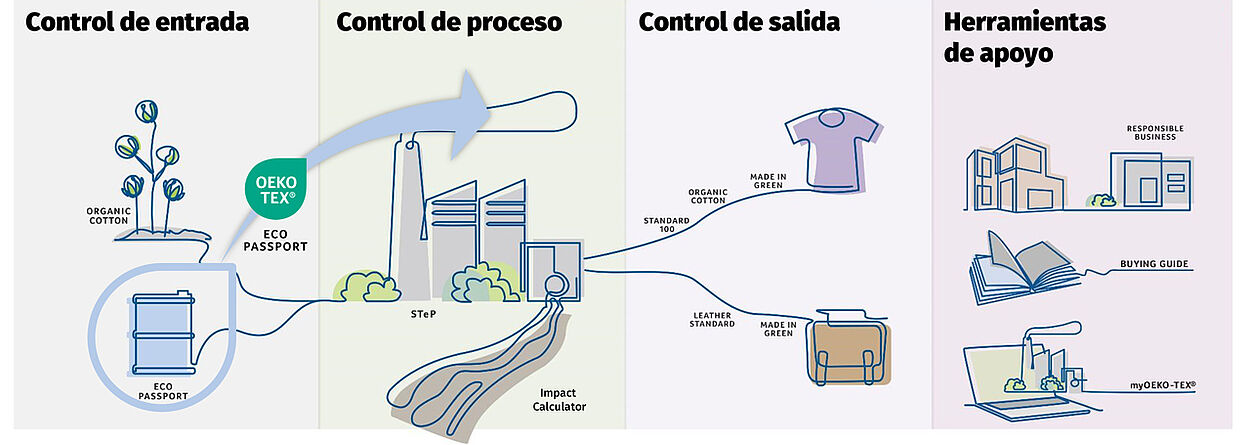
¿Se pueden certificar biocidas o ingredientes retardantes de llama?
Los biocidas biológicamente activos y las sustancias ignífugas deben estar aprobados en la lista de productos químicos activos OEKO-TEX® antes de ser utilizados en productos con cualquier certificación OEKO-TEX®.
Póngase en contacto con nosotros para iniciar el proceso de aprobación.

